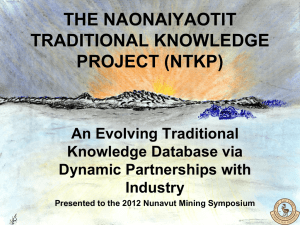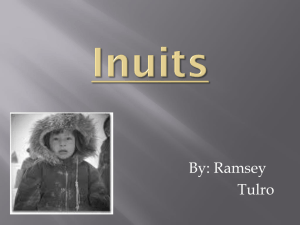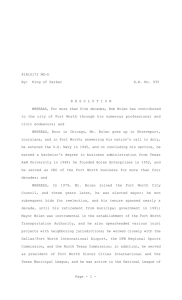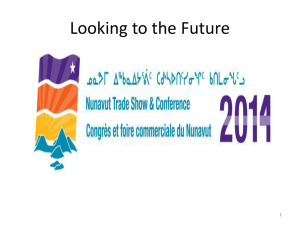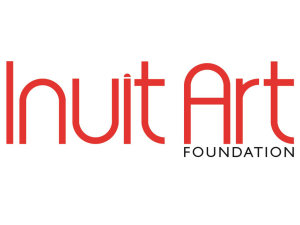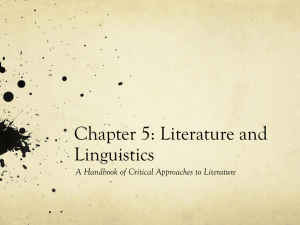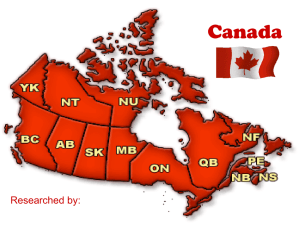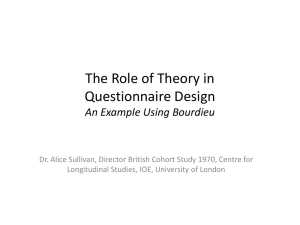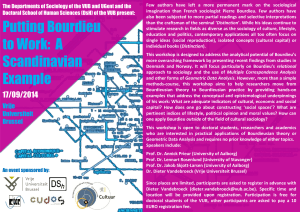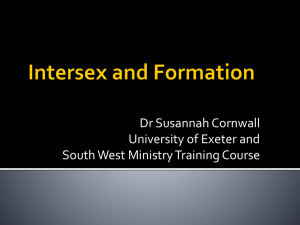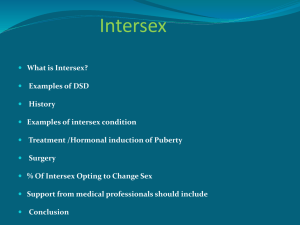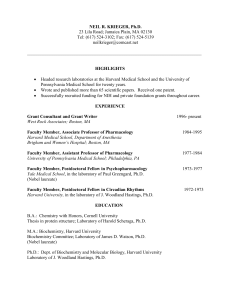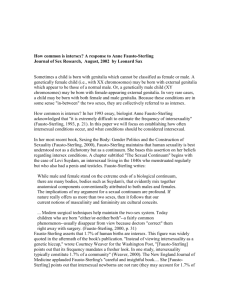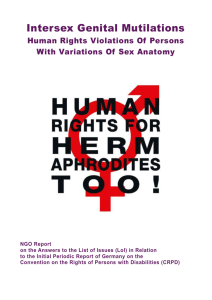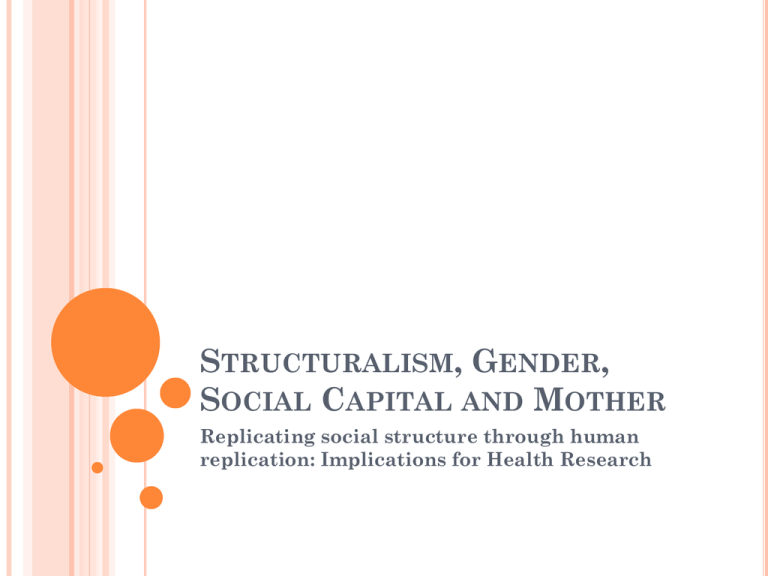
STRUCTURALISM, GENDER,
SOCIAL CAPITAL AND MOTHER
Replicating social structure through human
replication: Implications for Health Research
OVERVIEW
Social capital
Structuralism
Bourdieu
Replications of structures
Sex as Structure
Concept of mother as conflation of sex/gender
structure
Health implications of social capital and construction
of “mother”
Case Study/Methods Implications
SOCIAL CAPITAL
Marx: Society is the ensemble of social relationships,
and these relationships exist independently of
individual consciousness and will.
3 Types of Capital: Social, Economic and Cultural
Social Capital has many definitions, but can be
generalized to: the extent to which members of a
community view themselves as an “us” and the extent
to which they work towards a common good that
produces a network of resources; it is a type of
productivity that is only possible “en masse”.
This is then complicated with the idea that the
“…creation of difference is the foundation on which
inequality rests.” (Risman, 2004)
Social Capital is then both an asset and a constriction, as the
creation of a group is simultaneously a creation of difference and
therefore inequality as well as a positive asset created by social
interactions.
STRUCTURALISM
"the belief that phenomena of human life are not intelligible
except through their interrelations. These relations constitute a
structure, and behind local variations in the surface phenomena
there are constant laws of abstract culture".
Similar to Marx, in that these structures operate outside of human
agency.
Social structures reproduce themselves.
Claude Levi-Strauss: meaning is produced and reproduced in
culture through various practices due to underlying, universal
structure. Actions are governed by the structure, not individual
agency.
He believed that as every culture has an underlying structure which
governs every interaction, studies of culture should examine cultural
practices, such as kinship systems, food preparation and myth, as
these will demonstrate the underlying structure of the society. He
believed that these structures governing human behavior were based
on/created by the human mind, which operates on binary oppositions
(male/female, hot/cold, cooked/raw, “us”/ “them”).
BOURDIEU
Bourdieu “sociology of culture”: Critique on structuralism by
questioning how much human agency and practice engages with the
structures to which we belong; instead of us being governed by the
“deep” structures of Levi-Strauss, how do we negotiate our actions
within these structures? (How do we negotiate multiple concepts of
mother?)
Social Capital:"Social capital is the sum of the resources, actual or
virtual, that accrue to a group by virtue of possessing a durable
network of more or less institutionalized relationships of mutual
acquaintance and recognition“ (Bourdieu, 1986). (How does the
concept of mother improve social capital and disable social capital?)
Habitus: the result of the objective social structures into the
subjective experience of agents; predisposes one to appreciate and
prefer certain practices over another (Ex. Smoking?)
As social capital is based on networks, and individual agents operate in
their “habitus”, structures are maintained and social capital re-ifies Social
Economic Status and therefore reinforces inequality. (As we’ll discuss in
the case-study further on)
Each individual occupies a position is a multidimensional “social space” that is
not defined by class membership, but by every kind of capital articulated
through social relations.
What happens when this social capital is removed?
SEX AS STRUCTURE?
Sex is biological, but is the concept of sex in Western science necessarily
biological?
Concept of sex in Western science has changed through history:
Through time, ideas of sex have been based on different criteria, Laqueur, 1990 used images and
words from historical medical documents to argue that a one-sex model dominated from the Classic
period until the Enlightenment (e.g. Christopher Columbus court case)
Sexing practices within contemporary America use gender to define sex.
“…standard Western clinical practice recognizes four components of the term sex:
chromosomal, gonadal, morphological, and pyschosexual or gender identity,” (Arnold,
2002: 239-240).
Throughout the 20th century, medical practitioners regarded intersex as pathological and advocated
surgical and hormonal intervention soon after birth (Fausto-Sterling, 2000); (Geller, 2008).
American Academy of Pediatrics (AAP) in 2006 issued a “Consensus Statement on the Management
of Intersex Disorders” , where intersex is defined as a disorder. This statement was written to define
best practice for these “disorders” (DSD’s or ‘disorders of sex development’).
“A key point to emphasize is that the child with a DSD has the potential to become a well-adjusted,
functional member of society’ (AAP, 2006: e490). One key definer of quality of life is “the opportunity
to marry and raise children” (AAP, 2006: e493).
How might the authoritative discourse of abnormal from medical practitioner to parents
replicate/re-ify histrionic responses?
Expensive, invasive surgeries that are often cosmetic? What if the re-assigned gender is not
he “correct” one? What about death resulting from surgery?
How much power should biomedicine have in influencing decisions about sex/gender?
Public Health Issue: large number s of intersex individuals are forced into sex work and
therefore have higher rates of STIs and drug addictions. Should they simply conform to
male/female roles to avoid this fate? Is this a public health issue?
SEX AS STRUCTURE (CONT.)
Sex itself is not static: “…both males and females display increasing
‘masculinization’ of the greater sciatic notch as they grow older,” (Walker,
2005); (Geller, 2008). Also, securely sexed women develop more robust
crania as they age (Walker 1995).
These differences exist between populations as well as among them.
That said, I am not suggesting that male/female biological difference does
not exist, just that it is not quite so binary as we would perhaps like to
think and that perhaps “…maintaining the distinction while viewing sex
and gender as part of an interconnected continuum rather than as a set of
distinctive binary oppositions,” (Arnold, 2002: 239) would be a better way
to conceptualize the relationship between sex and gender.
Is this a possible endeavor? How can we change this dichotomy into a
continuum? (Ex. Surveys, logisitic regression, etc.)
FEMALE ROLE OF MOTHER
A useful concept for understanding the intersection of
sex and gender is through the concept of Mother.
(Bolen, 1992)
“Motherhood integrates bio-procreational and social
processes; it includes notions of sexuality,
reproduction, personhood, child care, social order,
domestic organization and power,” (Bolen, 1992).
“In our society, childbearing and child care hinders
participation within wider society,” (Bolen, 1992)
“Women’s perceived natural “motherly” instincts of
caring and concern make them good nurses, care
providers, elementary teachers; job patterns reflect
this,” (Bolen, 1992)
How might mothering roles limit ones’ social capital?
MOTHER: BIOLOGY
Biological fact that women give birth.
BUT: distinction between mothering labour and birthing labour.
Human reproduction requires pregnancy, however, the physical
“limitation” of this act varies:
Lactation varies at many levels: frequency, length of time, multiple feeders of
children, non-biological mothers feeding; proximity between mother and child
is convenient, but not necessary-they only need to be fed; some women can’t
breast feed at all. (e.g. formula)
“Constraints on activity and divisions of labor change if one can feed
sporadically and leave the baby with others in between,” (Bolen, 1992).
Ex. Women in 18th century and wet nurses.
The required physical intimacy/closeness of the human baby does not
have to be from the mother: multi-attachment system, not just monotrophy in
primate systems.
Mother Instinct: Ensuring the baby lives is a cultural construction based on
how “mother” is conceptualized: if a society cannot support the baby, the
culture develops ways that the child may be killed (i.e. “passive” neglect,
where the biological mothers are not responsible for this “tragedy”.)
Children born of biological mothers dying in childbirth would require
alternative care-takers.
In fact, biology seems to prefer a multi-attachment system of child rearing
instead of a monotrophic “mother” system.
MOTHER (CONT.)
In anthropological conceptions, cross-cultural and
ethnographic research demonstrate tremendous
variety in cultural conceptions of “mother”.
“Bowlby’s classic work on attachment suggests
that the patterns of attachment shown by men
(as fathers) resembled that of women (as
mothers)…reinforces the interchangeability of
women mothers and men fathers as care givers,”
(Bolen, 1992).
Only by addressing our Western conception of
Mother can we then move past gendered
assumptions of what being female entails
CASE-STUDY: INUIT WOMAN GIVING BIRTH
IN OTTAWA
Background: “Although midwifery was an integral part of traditional
Inuit culture, the official “standard” of maternity care that developed in
the mid 1970s for many northern Canadian communities was the
evacuation of all pregnant women to hospitals to give birth, often in
distant southern Canada. Women were flown south at 36 weeks’ gestation
or earlier, spending weeks and sometimes months away from home. As
stated in a report to the Quebec Ministry of Health, “This intimate,
integral part of our life was taken from us and replaced by a medical
model that separated our families, stole the power of the birthing
experience from our women, and weakened the health, strength, and
spirit of our communities,” (Van Wagner et al., 2007).
Inuit woman giving birth in Ottawa:
Social Capital of this woman?
Social structures underlying her giving birth in Ottawa in the first place?
If Social Capital is: “…members feel they can, and should, cooperate and take collective action to support the
good of the community,” how does this fit into the Inuit and First Nations issues in Canada?
1st Nations/Inuit more likely to participate in community care than their Canadian counterparts both at
an elementary school level and as adults
Interpersonal trust and norms of mutual aid and reciprocity are highly valued in Inuit culture.
Possible ways that this could have been prevented?
The Western concept of “mother” and this woman:
Western notion that biological mother is primary care-taker automatically. (Conflates
biological birth labor with mothering labour).
SEX/GENDER AND HEALTH RESEARCH
“…we do not live as a ‘gendered’ person one day
and a ‘sexed’ organism the next; we are both,
simultaneously, and for any given health
outcome, it is an empirical question, not a
philosophical principle, as to whether diverse
permutations of gender and sex matter,”
(Krieger, 2002).
“…epidemiological and other health research has
been hampered by a lack of clear conceptual
models for considering both, simultaneously, to
determine their relevance—or not—to the
outcome(s) being researched,” (Krieger, 2002)
EPIDEMIOLOGICAL METHOD
IMPLICATIONS
“Because our science will only be as clear and errorfree as our thinking, greater precision about whether
gender relations, sex-linked biology, both, or neither
matter for health is warranted,” (Krieger, 2002)
Example: CCHS asks interviewer to determine sex on site,
and then if they don’t know, to ask the participant: this
answers neither sex nor gender.)
Therefore, epidemiology as a practice re-ifies sex as a
structure through this process (questionnaires and
then studies based on those questionnaires both
define sex as binary and then replicate this definition
throughout society when the study is published.
How much/in what ways might epidemiology be harming
internal/external study validity through misconceptualizations of gender and sex?
Much debate about BMI not being an extremely accurate
estimate of body composition, but less on quantification of
sex/gender.
FINAL THOUGHTS
“I believe the rainbow always has more colors
than society has categories, and that society is
always trying to cram humanity’s rainbow into
the few categories it does have…The biology I
know tells of endless variation, not of a few
universals,” (Roughgarden, 2004: 396).
Natural differences as foundation for cultural
(re)formations and responses?
Public health implications? On Depression? Social support?
Vulnerable populations? We changed conceptions of
homosexuality and reduced stigma for HIV/AIDS, but how
to change format of those pesky questionnaires? Public
consciousness?


